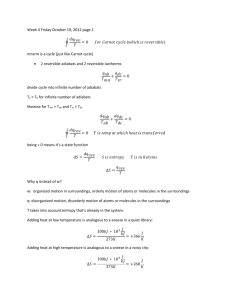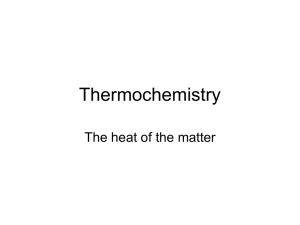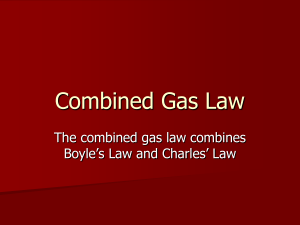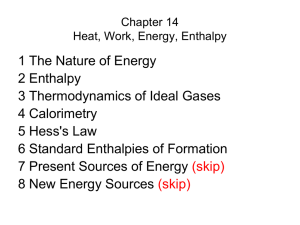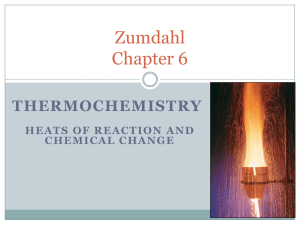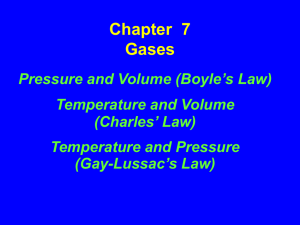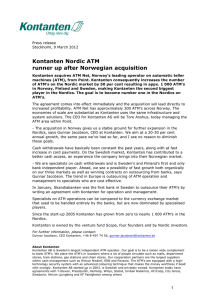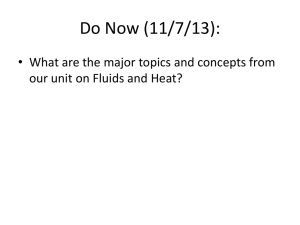Set 1
advertisement
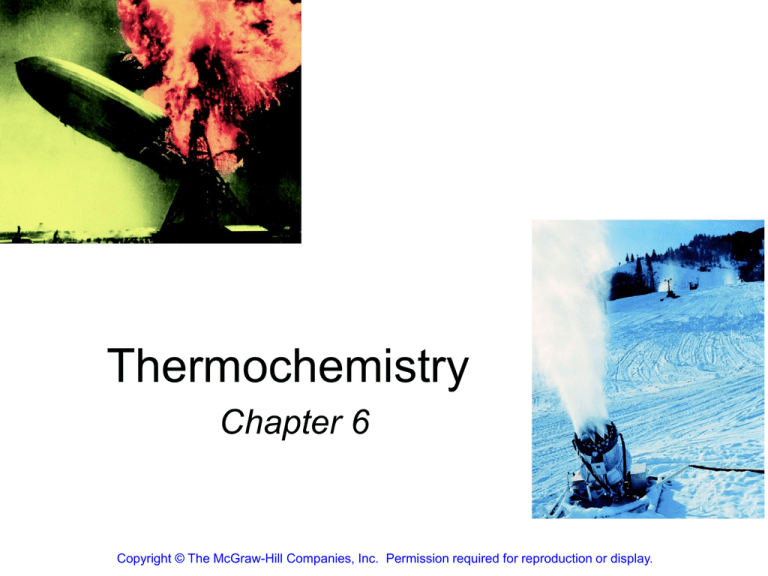
Thermochemistry Chapter 6 Copyright © The McGraw-Hill Companies, Inc. Permission required for reproduction or display. Energy is the capacity to do work. • Radiant energy comes from the sun and is earth’s primary energy source • Thermal energy is the energy associated with the random motion of atoms and molecules • Chemical energy is the energy stored within the bonds of chemical substances • Nuclear energy is the energy stored within the collection of neutrons and protons in the atom • Potential energy is the energy available by virtue of an object’s position 2 Temperature v. Heat Heat is the transfer of thermal energy between two bodies that are at different temperatures. Temperature is a measure of the thermal energy. Temperature = Thermal Energy In other words… Temperature is a measure of the KE of the system, related to the random motions of particles. Heat involves a transfer of energy between two objects due to a difference in temperature. 3 Thermochemistry is the study of heat change in chemical reactions. Dropping Lead Shot 1. Measure the temperature of the lead shots in your bag 2. Drop the bag from about 2m high to the ground 3. Repeat for approximately 2 minutes 4. Check the temperature of the lead shots again. 4 Thermochemistry is the study of heat change in chemical reactions. The system is the specific part of the universe that is of interest in the study. open Exchange: mass & energy closed isolated energy nothing 5 Exothermic process is any process that gives off heat – transfers thermal energy from the system to the surroundings. 2H2 (g) + O2 (g) H2O (g) 2H2O (l) + energy H2O (l) + energy Endothermic process is any process in which heat has to be supplied to the system from the surroundings. energy + 2HgO (s) energy + H2O (s) 2Hg (l) + O2 (g) H2O (l) 6 Schematic of Exothermic and Endothermic Processes 7 Thermodynamics is the scientific study of the interconversion of heat and other kinds of energy. State functions are properties that are determined by the state of the system, regardless of how that condition was achieved. energy, pressure, volume, temperature Potential energy of hiker 1 and hiker 2 is the same even though they took different paths. 8 STATE FUNCTION Suppose we have a gas at 2 atm, 300K, and 1L. At constant temperature, we decrease the pressure to 1 atm. What happens to the volume? DV = Vfinal – Vinitial DV = 2L – 1L DV = 1L What if we first doubled the pressure first and then decreased the pressure to ¼ its value. What is the volume now? DV = 1L DE = Efinal - Einitial DP = Pfinal - Pinitial DV = Vfinal - Vinitial DT = Tfinal - Tinitial 10 First law of thermodynamics – energy can be converted from one form to another, but cannot be created or destroyed. Law of Conservation of Energy!! C3H8 + 5O2 3CO2 + 4H2O Exothermic chemical reaction! Chemical energy lost by combustion = Energy gained by the surroundings system surroundings 11 We cannot calculate the total energy of a system at any given point. We can only calculate the change in energy. DEsystem + DEsurroundings = 0 or DEsystem = -DEsurroundings C3H8 + 5O2 3CO2 + 4H2O Exothermic chemical reaction! 12 Another form of the first law for DEsystem DE = q + w DE is the change in internal energy of a system q is the heat exchange between the system and the surroundings w is the work done on (or by) the system 13 The internal energy of the balloon hasn’t changed. When it expands, the system does 10J of work. How much heat is added or taken away? 14 Work Done On the System w=Fxd w = -PDV when a gas expands against a constant external pressure PxV= F 3 = Fx d = w x d d2 DV > 0 -PDV < 0 wsys < 0 initial final Work is not a state function. Dw = wfinal - winitial 15 A sample of nitrogen gas expands in volume from 1.6 L to 5.4 L at constant temperature. What is the work done in joules if the gas expands (a) against a vacuum and (b) against a constant pressure of 3.7 atm? w = -P DV (a) DV = 5.4 L – 1.6 L = 3.8 L P = 0 atm W = -0 atm x 3.8 L = 0 L•atm = 0 joules (b) DV = 5.4 L – 1.6 L = 3.8 L P = 3.7 atm w = -3.7 atm x 3.8 L = -14.1 L•atm w = -14.1 L•atm x 101.3 J = -1430 J 1L•atm Why is work not a state function? 16 Problem 6.16 A gas expands in volume from 26.7 mL to 89.3 mL at constant temperature. Calculate the work done (in joules) if the gas expands (a) against a vacuum (b) against a constant pressure of 1.5 atm (c) against a constant pressure of 2.8 atm. 17 Work done when a gas is compressed in a cylinder like the one below is 462 J. During this process, there is a heat transfer of 128 J from the gas to the surroundings. Calculate the energy change for this process. DE = q + w DE= -128 J + 462 J DE= 334 J 18 Problem 6.18 • The work done to compress a gas is 74 J. As a result, 26 J of heat is given off to the surroundings. Calculate the change in energy of the gas. 19 Enthalpy and the First Law of Thermodynamics DE = q + w At constant pressure: q = DH and w = -PDV DE = DH - PDV DH = DE + PDV 20 Is the following reaction endothermic or exothermic? CO2(g) + 2H2O(l) CH4(g) + 2O2(g) ΔH = 890.4 kJ/mol 2SO2(g) + O2(g) 2SO3(g) ΔH = -198.2 kJ/mol CH4(g)+ 2O2(g) CO2(g) + 2H2O(g) H2O(l) H2O(s) 21 Enthalpy (H) is used to quantify the heat flow into or out of a system in a process that occurs at constant pressure. DH = H (products) – H (reactants) DH = heat given off or absorbed during a reaction at constant pressure Hproducts > Hreactants DH > 0 Hproducts < Hreactants DH < 0 22 Thermochemical Equations Is DH negative or positive? System absorbs heat Endothermic DH > 0 6.01 kJ are absorbed for every 1 mole of ice that melts at 00C and 1 atm. H2O (s) H2O (l) DH = 6.01 kJ 23 Thermochemical Equations Is DH negative or positive? System gives off heat Exothermic DH < 0 890.4 kJ are released for every 1 mole of methane that is combusted at 250C and 1 atm. CH4 (g) + 2O2 (g) CO2 (g) + 2H2O (l) DH = -890.4 kJ 24 Thermochemical Equations • The stoichiometric coefficients always refer to the number of moles of a substance H2O (s) • DH = 6.01 kJ If you reverse a reaction, the sign of DH changes H2O (l) • H2O (l) H2O (s) DH = -6.01 kJ If you multiply both sides of the equation by a factor n, then DH must change by the same factor n. 2H2O (s) 2H2O (l) DH = 2 x 6.01 = 12.0 kJ 25 Thermochemical Equations • The physical states of all reactants and products must be specified in thermochemical equations. H2O (s) H2O (l) DH = 6.01 kJ H2O (l) H2O (g) DH = 44.0 kJ How much heat is evolved when 266 g of white phosphorus (P4) burn in air? P4 (s) + 5O2 (g) 266 g P4 x P4O10 (s) 1 mol P4 123.9 g P4 x DH = -3013 kJ 3013 kJ = 6470 kJ 1 mol P4 26 Problem 6.26 Determine the amount of heat (in KJ) given off when 1.26x104 g of NO2 are produced according to the equation 2NO(g) + O2(g) 2NO2(g) ∆H = -114.6 kJ 27 A Comparison of DH and DE 2Na (s) + 2H2O (l) At 25 oC and 1 atm 2NaOH (aq) + H2 (g) DH = -367.5 kJ DE = DH - PDV PDV = 1 atm x 24.5 L = 2.5 kJ DE = -367.5 kJ – 2.5 kJ = -370.0 kJ 28 Example 6.4 Calculate the change in internal energy when 2 mol of CO are converted to 2 moles of CO2 at 1 atm and 25°C 2CO(g) + O2(g) 2CO2(g) ΔH = -566.0 kJ 29 Problem 6.28 Consider the reaction H2(g) + Cl2(g) 2HCl(g) ∆H = -184.6 kJ If 3 moles of H2 react with 3 moles of Cl2 to form HCl, calculate the work done (in joules) against a pressure of 1.0 atm at 25ºC. What is ∆E for this reaction? Assume the reaction goes to completion. 30
